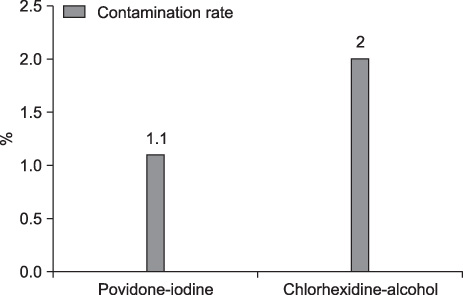Korean J Clin Microbiol.
2012 Mar;15(1):37-42. 10.5145/KJCM.2012.15.1.37.
Comparison of Chlorhexidine-Alcohol and Povidone-Iodine for Skin Antisepsis and the Effect of Increased Blood Volume in Blood Culture
- Affiliations
-
- 1Department of Pharmacy, Gyeongsang National University Hospital, Jinju, Korea.
- 2Department of Emergency Medicine, Gyeongsang National University School of Medicine, Jinju, Korea.
- 3Department of Laboratory Medicine, Institute of Health Sciences, Gyeongsang National University School of Medicine, Jinju, Korea. sjkim8239@hanmail.net
- KMID: 2224859
- DOI: http://doi.org/10.5145/KJCM.2012.15.1.37
Abstract
- BACKGROUND
Reducing skin contamination rate and improving the positive rate in blood culture is essential for the correct diagnosis and management of sepsis. Chlorhexidine-alcohol was compared with povidone-iodine for the efficiency of disinfection. Positive rates were compared between the collection of 10 mL and 20 mL of blood per sample.
METHODS
The study population included adult patients > or = 18 years old requested for blood culture in the Emergency Department. Povidone-iodine (10%) was used for antiseptic skin preparation from March to June 2011, and 0.5% chlorhexidine-alcohol from July to October 2011. The standard for blood collection was 10 mL in the first period and 20 mL in the second period. The dedicated phlebotomists had been educated on the optimal skin preparation and sample collection.
RESULTS
After 10% povidone-iodine application, 31 of 2,755 samples (1.1%) were considered to be contaminated; whereas, a total of 60 of 3,064 samples (2.0%) were contaminated (P=0.011) after application of 0.5% chlorhexidine-alcohol. The positive rate of blood culture was 12.5% (345/2,755) in the first period versus 17.1% (524/3,064) in the second period (P<0.001).
CONCLUSION
Both disinfectants appeared acceptable for skin preparation for blood culture collection, although chlorhexidine-alcohol had a higher contamination rate than povidone-iodine. The positive rate of blood culture was in accordance with the amount of sample collected. Continuous education and monitoring are needed for the proper collection and management of blood culture.
Keyword
MeSH Terms
Figure
Cited by 2 articles
-
Compliance with Blood Volumes Collected for Blood Cultures between Physicians and Phlebotomists
Eun-ha Koh, Sunjoo Kim, Dong-hyun Lee, Seong Chun Kim
Ann Clin Microbiol. 2013;16(2):81-86. doi: 10.5145/ACM.2013.16.2.81.Nationwide Survey of Blood Culture Protocol in Clinical Microbiology Laboratories in Korea
Young Ah Kim, Dokyun Kim, Dongeun Yong
Ann Clin Microbiol. 2016;19(4):97-104. doi: 10.5145/ACM.2021.19.4.97.
Reference
-
1. Souvenir D, Anderson DE Jr, Palpant S, Mroch H, Askin S, Anderson J, et al. Blood cultures positive for coagulase-negative staphylococci: antisepsis, pseudobacteremia, and therapy of patients. J Clin Microbiol. 1998. 36:1923–1926.2. Little JR, Murray PR, Traynor PS, Spitznagel E. A randomized trial of povidone-iodine compared with iodine tincture for venipuncture site disinfection: effects on rates of blood culture contamination. Am J Med. 1999. 107:119–125.3. Hall KK, Lyman JA. Updated review of blood culture contamination. Clin Microbiol Rev. 2006. 19:788–802.4. Cockerill FR 3rd, Wilson JW, Vetter EA, Goodman KM, Torgerson CA, Harmsen WS, et al. Optimal testing parameters for blood cultures. Clin Infect Dis. 2004. 38:1724–1730.5. Mimoz O, Karim A, Mercat A, Cosseron M, Falissard B, Parker F, et al. Chlorhexidine compared with povidone-iodine as skin preparation before blood culture. A randomized, controlled trial. Ann Intern Med. 1999. 131:834–837.6. Eskira S, Gilad J, Schlaeffer P, Hyam E, Peled N, Karakis I, et al. Reduction of blood culture contamination rate by an educational intervention. Clin Microbiol Infect. 2006. 12:818–821.7. Riedel S, Carroll KC. Blood cultures: key elements for best practices and future directions. J Infect Chemother. 2010. 16:301–316.8. Li J, Plorde JJ, Carlson LG. Effects of volume and periodicity on blood cultures. J Clin Microbiol. 1994. 32:2829–2831.9. CLSI. CLSI document M47-A. 2007. Principles and procedures for blood cultures; approved guideline. 2007. Wayne, PA: Clinical and Laboratory Standards Institute.10. Bouza E, Sousa D, Rodríguez-Créixems M, Lechuz JG, Muñoz P. Is the volume of blood cultured still a significant factor in the diagnosis of bloodstream infections? J Clin Microbiol. 2007. 45:2765–2769.11. Towns ML, Jarvis WR, Hsueh PR. Guidelines on blood cultures. J Microbiol Immunol Infect. 2010. 43:347–349.12. Shin JH, Song SA, Kim MN, Lee NY, Kim EC, Kim S, et al. Comprehensive analysis of blood culture performed at nine university hospitals in Korea. Korean J Lab Med. 2011. 31:101–106.13. Darby JM, Linden P, Pasculle W, Saul M. Utilization and diagnostic yield of blood cultures in a surgical intensive care unit. Crit Care Med. 1997. 25:989–994.14. Weinstein MP. Blood culture contamination: persisting problems and partial progress. J Clin Microbiol. 2003. 41:2275–2278.15. Malani A, Trimble K, Parekh V, Chenoweth C, Kaufman S, Saint S. Review of clinical trials of skin antiseptic agents used to reduce blood culture contamination. Infect Control Hosp Epidemiol. 2007. 28:892–895.16. Schifman RB, Strand CL, Meier FA, Howanitz PJ. Blood culture contamination: a College of American Pathologists Q-Probes study involving 640 institutions and 497134 specimens from adult patients. Arch Pathol Lab Med. 1998. 122:216–221.17. Shahar E, Wohl-Gottesman BS, Shenkman L. Contamination of blood cultures during venepuncture: fact or myth? Postgrad Med J. 1990. 66:1053–1058.18. Baron EJ, Weinstein MP, Dunne WM Jr., Yagupsky P, Welch DF, Wilson DM. Baron EJ, editor. Cumitech 1C, blood cultures IV. 2005. Washington, D.C.: ASM Press.19. Shin JH, Song SA, Kim MN, Kim S. Nationwide survey of blood culture performance regarding skin disinfection, blood collection and laboratory procedures. Korean J Clin Microbiol. 2011. 14:91–96.
- Full Text Links
- Actions
-
Cited
- CITED
-
- Close
- Share
- Similar articles
-
- Chlorhexidine Versus Povidone Iodine in Bacterial Contamination Rate of Needles Used for Spinal Anesthesia
- Clinical comparison of antibacterial effect of skin disinfectants used in surgical field of orthognathic surgical patients:povidone-iodine and chlorhexidine
- Two Cases of Allergic Contact Dermatitis due to Povidone-iodine
- Comparison of Blood Culture Contamination Rate Before and After Improving Skin Antisepsis Methods in Blood Culture
- The role of skin antisepsis in upper extremity surgery to reduce surgical site infection: a comparison between single and triple regimens



